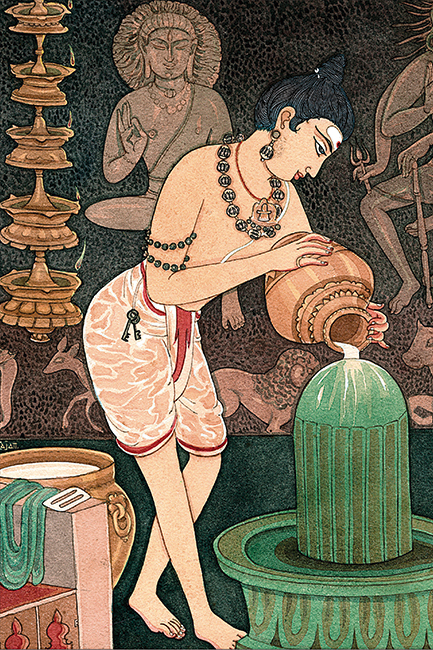PUBLISHER’S DESK • JANUARY 2015§
The Aim of Hindu Practices
______________________§
Dharma, seva, puja and raja yoga lead to purification of the mind, which is the essence of all spiritual endeavors§
______________________§
BY SATGURU BODHINATHA VEYLANSWAMI§
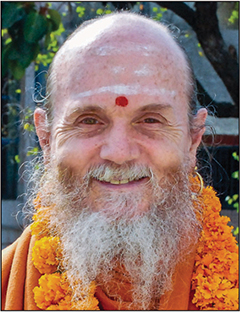 OFTEN IN PRESENTING HINDUISM’S practices, the actions themselves are described with little or no explanation of their purpose. This may have worked well in days of yore, but today practitioners demand clear reasons and insights into their sadhanas. Four traditional practices can inform our exploration. 1) Hindus are taught to follow dharma and refrain from adharmic actions, such as harming others, stealing and lying. 2) Seva, selfless service, is to be done regularly. 3) Puja is performed or attended in the home shrine daily, and weekly at a nearby temple. 4) The disciplines of raja yoga, which include profound forms of meditation, are a daily practice for the most devout.§
OFTEN IN PRESENTING HINDUISM’S practices, the actions themselves are described with little or no explanation of their purpose. This may have worked well in days of yore, but today practitioners demand clear reasons and insights into their sadhanas. Four traditional practices can inform our exploration. 1) Hindus are taught to follow dharma and refrain from adharmic actions, such as harming others, stealing and lying. 2) Seva, selfless service, is to be done regularly. 3) Puja is performed or attended in the home shrine daily, and weekly at a nearby temple. 4) The disciplines of raja yoga, which include profound forms of meditation, are a daily practice for the most devout.§
What makes these practices important? A rationale for religious practices in Western faiths is that they define the good path which leads the observant to heaven. However, that is not why they are important in Hinduism and other Eastern religions.§
To begin answering the above question, let’s examine a core Hindu belief: man’s innate divinity. Gurudeva, Sivaya Subramuniyaswami, articulated it beautifully: “Deep inside we are perfect this very moment, and we have only to discover and live up to this perfection to be whole. We have taken birth in a physical body to grow and evolve into our divine potential. We are inwardly already one with God. Our religion contains the knowledge of how to realize this oneness and not create unwanted experiences along the way.”§
An analogy will illustrate this idea. Imagine a pond of water with large gold nuggets at the bottom. If the surface of the pond has ripples due to wind, or if the water is clouded by mud or pollution, we cannot see the gold nuggets from above. The nuggets represent our soul nature; the ripples on the surface of the pond represent an active intellectual mind; and the water’s cloudiness represents subconscious impurities. In order to experience our soul nature and its oneness with God, our intellect must be quiet and our mind must be pure. We also need to be a sensitive and humble observer.§
This analogy reveals the answer to our question “What is the reason Hindu spiritual practices are important?” They are important because of their impact on our mind. That impact is threefold: 1) they purify the mind; 2) they quiet the intellect and 3) they spiritualize the ego, thereby allowing us to eventually experience our divine essence. Here I will focus on the first of these, but keep in mind that the other two are equally essential to spiritual progress and effort.§
An entry in the Encyclopedia of Hinduism (India Heritage Research Foundation) tells us: “Shuddhi means purification. Chitta is mind. Purification of the mind (chitta-shuddhi) may be called the essence of all spiritual endeavors.” Purification is the process of removing or resolving subconscious impressions, called samskaras, of past misdeeds and troublesome experiences from this and past lives. Note that more commonly samskara refers to a sacrament or rite done to mark a significant transition in life, such as the marriage rite, vivaha samskara. These sacraments make deep and positive impressions on the mind of the recipient, inform the family and community of changes in the lives of its members and secure inner-world blessings. Here the term samskara refers to the imprints left on the subconscious mind by all experience, which then mold one’s nature and affect the course of life.§
The Encyclopedia explains, “Mental impurities are the root cause of pleasure and pain, and therefore they perpetuate the cycle of birth and death. Breaking this cycle and thus putting an end to sorrow (duhkha) is the goal of Hindu religion and philosophy. The surest means of achieving this goal is chitta-shuddhi.” The four practices mentioned above—dharma, seva, puja and yoga—purify the mind in the following ways.§
Dharma: Adhering to dharma and refraining from adharmic actions, such as harming others, stealing and lying, assures that we are not increasing the mind’s impurity.§
Seva: Also known as karma yoga, seva is a powerful tool for reducing mental impurities. Adi Shankara expressed this in Vivekachudamani: “Work is for the purification of the mind, not for the perception of Reality. The realization of Truth is brought about by discrimination, not in the least by ten millions of acts.” My guru encouraged devotees to perform four hours of seva each week, especially service focused on helping others: “Lift their burdens just a little bit and, unknowingly perhaps, you may lift something that is burdening your mind. You erase and wipe clean the mirror of your own mind through helping another. We call this karma yoga, the deep practice of unwinding, through service, the selfish, self-centered, egotistical vasanas of the lower nature that have been generated for many, many lives and which bind the soul in darkness.”§
Our own Hindu Lexicon explains, “Vasanas are subliminal inclinations and habit patterns which, as driving forces, color and motivate one’s attitudes and future actions and thereafter contribute to mental fluctuations, called vritti.” A vasana is created when two samskaras blend together, forming an amalgam that is stronger than either individual experiential impression. Swami Harshananda writes in A Concise Encylopaedia of Hinduism: “Vasana is a strong impression in the mind. It is so strong that, when it arises in the mind, a person is forced to act without thinking of the consequences.” Vasanas can be negative or positive. It is, of course, the negative ones we want to soften through seva.§
Puja: Attending pujas at a temple and in the home shrine, our third primary practice, purifies the mind through the exchange of prana, an aspect of puja and homa that is not often discussed. Puja is a process of giving prana to the Deity through offerings of fruit, cooked foods, water, incense, fragrant flowers and milk. Then, during the culminating arati, the Deity and his helpers, or devas, reflect back this prana into the aura of each devotee, purifying it of subconscious congestions. The devotee so blessed leaves feeling uplifted and relieved of mental burdens.§
After an elaborate homa performed in our Hawaii temple by his three priests, Jayendrapuri Mahaswamiji of Kailash Ashram in Bengaluru, India, explained that Agni, the messenger God of fire, conveys the offerings in a purified form to the Deity, who then uses the prana to bless those present. The effect of such blessings can be life-altering, as Gurudeva observed: “Darshan coming from the great temples of our Gods can change the patterns of karma dating back many past lives, clearing and clarifying conditions that were created hundreds of years ago and are but seeds now, waiting to manifest in the future. Through the grace of the Gods, those seeds can be removed if the manifestation in the future would not enhance the evolution of the soul.”§
Raja Yoga: Rishi Patanjali extols the purifying power of our fourth practice, raja yoga, in his Yoga Sutras: “When the [eight] limbs of yoga are practiced, impurities dwindle and radiant knowledge manifests, leading to discrimination as to their difference.” He particularly highlights the purifying effect of austerity, tapas, which is part of the second limb, niyama. Tiruvalluvar’s Tirukural provides this insight: “As the intense fire of the furnace refines gold to brilliance, so does the burning suffering of austerity purify the soul to resplendence.” This verse may bring to mind images of yogis subsisting on nettle soup in a remote Himalayan cave or bathing in freezing waters. Though tapas does embrace such intense practices, it also includes easier ones that can be done by anyone.§
A simple form of tapas is sacrifice, giving up a cherished possession—be it money, time or a physical object—to manifest a greater good. Sacrifice, while similar to charity, is distinguished by some form of self-denial. Examples I like are fasting for a day and giving the money saved to a Hindu institution, and saving money for charity by going on a budget vacation instead of a fancy one.§
Performing penance to atone for misdeeds is another form of tapas. This is done through such acts as 108 prostrations before the Deity in the temple, walking prostrations around a temple, and kavadi, a penance offered to Lord Murugan (also known as Karttikeya). Gurudeva elaborates, “Austerity is the powerful bath of fire and bright rays of showering light that washes the soul clean of the dross of its many past lives, and of the current life, which has held it in the bondage of ignorance, misgiving, unforgivingness and the self-perpetuating ignorance of the truths of the Sanatana Dharma.”§
We can take joy in the fact that Hindu practices well performed impact our mind and transform our consciousness. It is through purifying the mind, quieting the intellect and spiritualizing the ego that we are able to grow and evolve and ultimately experience our soul nature and its oneness with God. Our paramaguru, Yogaswami of Sri Lanka, described this process: “When worldly attachment and impurity of the mind disappear, then there is atma-darshan.”§
PUBLISHER’S DESK • JANUARY 2014§
A Ten-Minute Spiritual Workout
______________________§
An abbreviated daily regimen designed for those who find that today’s busy life allows little or no time for introspection§
______________________§
BY SATGURU BODHINATHA VEYLANSWAMI§
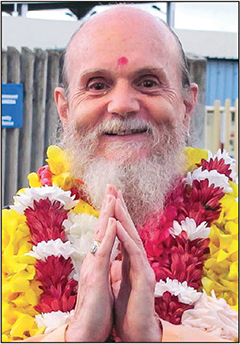 NOWADAYS THE IDEA OF PERFORMING A daily physical workout is widespread. Nearly everyone appreciates the need to stay fit and healthy for a productive, contented life. Three types of exercise are recommended: endurance, flexibility and strength. Each has specific benefits. Endurance activities, such as walking, running and swimming, increase vitality and keep the heart, lungs and circulatory system healthy. Flexibility activities, such as hatha yoga, T’ai Chi and dancing, keep the muscles relaxed and the joints mobile. Strength activities build muscle tissue and keep the skeletal system strong. These include calisthenics, weight/resistance exercises and climbing stairs.§
NOWADAYS THE IDEA OF PERFORMING A daily physical workout is widespread. Nearly everyone appreciates the need to stay fit and healthy for a productive, contented life. Three types of exercise are recommended: endurance, flexibility and strength. Each has specific benefits. Endurance activities, such as walking, running and swimming, increase vitality and keep the heart, lungs and circulatory system healthy. Flexibility activities, such as hatha yoga, T’ai Chi and dancing, keep the muscles relaxed and the joints mobile. Strength activities build muscle tissue and keep the skeletal system strong. These include calisthenics, weight/resistance exercises and climbing stairs.§
Taking care of our physical body is essential; but for optimum performance in life, all dimensions of our being need attention: physical, emotional/intellectual and spiritual. Each is important and deserves its share of attention. Of the three, the spiritual, or superconscious, dimension is typically the most neglected, even though it is the core of our being, our real identity. My Gurudeva wrote: “We have to adjust our subconscious to the idea that we are a superconscious being, rather than an instinctive being or an intellectual being driven by the impulses of the five senses. Awareness is the core of us.”§
We maintain physical health through exercises. We nourish our intellectual nature through learning new things all through life, expanding and strengthening our mental abilities. The emotional nature is sustained by tending closely to interpersonal relations, practicing surrender and acceptance, by striving to build good character qualities, serving others and living a balanced life.§
We give time to our spiritual nature by performing daily religious activities. I like to call this a spiritual workout. During this time, we are reminded that life’s inner purpose is to make spiritual progress, moving forward toward the ultimate goal of experiencing God, Self Realization, and subsequently moksha, liberation from the cycle of rebirth. It is not so much a matter of exercising our spiritual nature as it is taking time to experience it. The scripture Tirumantiram shares: “Step by step, practice withdrawal of the mind and look inward. One by one, you will witness the myriad good things within. Now and here below, you may meet the Lord for whom the ancient Veda still searches everywhere.”§
Generally we are so wrapped up in our outer nature that we are hardly aware of our true, glorious inner reality. This can go on life after life, as it does for many people, who only begin to think of greater realities when nearing the point of death.§
The benefits of such times of quiet retreat from life’s hustle and bustle are underrated and overlooked, as life in the 21st century becomes more and more hectic and externally demanding. Many orthodox families living in India still manage to reserve time for their spiritual being by performing an early morning puja in their home shrine, followed by repetition of a mantra while counting on japa beads.§
The predominant trend in India and other countries, however, is that fewer and fewer families follow such disciplines. Sitting with me, so many say the same thing: “We just can’t seem to find the time for puja, japa or meditation.” Time devoted to employment, transportation, eating, entertainment, physical exercise and spending time with family and friends takes up the whole day. The traditional one-hour daily religious workout is proving to be too long and, because the benefits are not well understood, it is commonly skipped altogether. My Gurudeva spoke of those benefits, “As a result [of your daily religious practices], you will be able to brave the forces of the external world without being disturbed by them and fulfill your dharma in whatever walk of life you have chosen. Because your daily sadhana has regulated your nerve system, the quality of your work in the world will improve, and your mood in performing it will be confident and serene.”§
So, what’s the solution? I focus primarily on the youth, for their patterns are not too rigid to change. I devised a ten-minute program consisting of four activities that can be performed whenever time is available. Hopefully, the brevity and flexibility of the time of day, along with a clear sense of the spiritual benefits, will motivate students to adopt this workout or, equally as good, customize a routine of their own. I suggest this practice be taken up around age fifteen and maintained throughout high school and university. After schooling, it is hoped that those serious about their spiritual life will increase their workout to half an hour.§
The spiritual workout consists of four activities: worship, introspection, affirmation and study. The worship portion involves repeating a mantra to a chosen Deity or reciting nine or more names of the Deity, offering grains of rice to a murti or picture with each repetition or name. For example, if worshiping Lord Ganesha, one might intone the mantra Aum Sri Ganeshaya Namah or another of your choice or lineage. Alternatively, a short bhajan can be sung while looking at the Deity’s picture or murti. Devote two minutes to this simple expression of reverence and gratitude.§
The introspection portion consists of chanting the mantra Aum nine times with eyes closed. For Aum japa to be effective, the mantra must be pronounced correctly. The first syllable is A, pronounced as the English word “awe,” but prolonged: “aaa.” The second syllable is U, as in “roof,” pronounced “oo,” but prolonged: “ooo.” The third syllable is M, pronounced “mm” with the front teeth gently touching and the sound prolonged: “mmmm.” Each repetition is sounded for about seven seconds, with two seconds on A, two seconds on U and three seconds on M, with a silence of about two seconds before the next repetition. The three syllables are run together: AAUUMMM (silence), AAUUMMM (silence), AAUUMMM (silence). On the first syllable, A, we feel the solar plexus and chest vibrating. On the second syllable, U, the throat vibrates. The third syllable, M, vibrates the top of the head. Devote two minutes to this.§
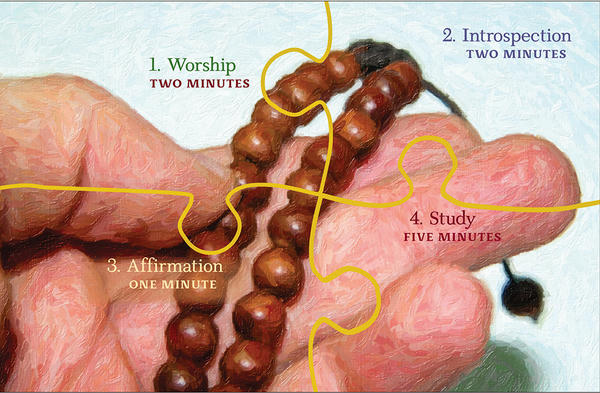
SHUTTERSTOCK§
Affirmations are statements repeated to oneself to place specific impressions in our subconscious mind to produce positive results in the future. This portion of the workout consists of repeating nine times the affirmation “I’m all right right now.” Two other affirmations that can be used are “All my needs will always be met” and “I can, I will, I am able to accomplish what I plan.” The threefold key to effectively utilizing affirmations is: 1) keep the mind focused on the meaning of what you are saying, 2) hold in your mind a visualization that shows the result you want to achieve and 3) feel in the present how you will feel later, when you have achieved what the affirmation describes. Devote one minute to this.§
The study portion consists of reading a sacred Hindu text that provides you new knowledge and insight. It is important to choose a work that you find clear and inspiring, avoiding those that seem obscure or technical. Devote five minutes to this.§
What are the benefits of these four religious practices? The benefit of the worship portion is that it increases our devotion to the Deity, enhancing our relationship with Him or Her. It is a natural first step toward eventually performing a full rite of worship (atmartha puja). The introspective practice of chanting Aum produces a calming effect on the mind and raises our energies into the more spiritual part of the mind, moving you into the higher chakras. It provides a natural first step toward the deeper practices of meditation, such as regulating our breath (pranayama) and withdrawing energy from the senses (pratyahara), focusing the thought process (dharana) leading to experiencing our inner soul nature (dhyana and samadhi). Repeating an affirmation each day helps us become more positive and self-confident, making us more successful in everything we do. Affirmations are also a great antidote to worry. The study of sacred texts increases knowledge of our faith and catalyzes insights into Hindu philosophy and practices.§
It is important to keep in mind that the amount of spiritual advancement we make toward our ultimate goal of experiencing God, Self-Realization, and the subsequent liberation from the cycle of rebirth, or moksha, is directly related to the amount of time we devote to religious practices.§
Sage Patanjali mentions this is in his Yoga Sutras (1.21-22): “For those who have strong dedication, samadhi is near. Whether one’s practice is mild, medium or intense also makes a difference.” The sage is indicating that spiritual progress is not based only on how much time we devote to our practices, but also on how much dedication, energy or effort we put into it. His third verse on this topic (1.23) states: “Samadhi may also come through devotion to Ishvara.” This means that effort and dedication can be supplemented by the blessings or grace we receive due to our intense devotion to God.§
PUBLISHER’S DESK • OCTOBER 2014§
Path to Higher Consciousness
______________________§
How following Hindu principles develops the refined character needed to move from anger and fear into lofty states of mind§
______________________§
BY SATGURU BODHINATHA VEYLANSWAMI§
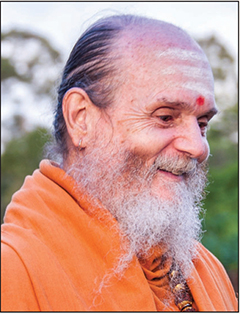 IT IS NOT UNCOMMON TO HEAR HINDUS ASK rhetorically, “Aren’t all religions pretty much the same?” In fact, people of all faiths can be heard asking this. A related statement echoes this sentiment: “Living a virtuous life and helping your fellowman is the essence of all religions, isn’t it?”§
IT IS NOT UNCOMMON TO HEAR HINDUS ASK rhetorically, “Aren’t all religions pretty much the same?” In fact, people of all faiths can be heard asking this. A related statement echoes this sentiment: “Living a virtuous life and helping your fellowman is the essence of all religions, isn’t it?”§
Our editors’ study of the world’s major religions finds similarities but also significant differences between religions. By presenting information on the world’s religions in brief and easily comparable write-ups, the article seeks to dispel “the myth that all religions are one, that they all seek to lead adherents by the same means to the same Ultimate Reality.” They don’t, as a conscientious review of the article will show.§
For example, from the Hindu perspective, it is not the attainment of heaven that is difficult. Remaining there is the challenge, as explained in the Mundaka Upanishad. After death those who have performed daily rituals and humanitarian works earn the grace of access to heaven. However, the merit of their good deeds is eventually exhausted, and they are once again born on Earth. The Upanishad offers two ways to remain in heaven and ultimately transcend that realm and merge in eternal oneness with God. The first is the attainment of a serene mind and controlled senses, which leads to renunciation of the world and the acceptance of a guru capable of guiding seekers to God Realization. The second path is retirement to the forest in one’s elderly years, there to live in solitary, performing intense austerities and worship of a Deity. To the Hindu mind it makes sense that achieving a permanent stay in heaven requires more than mere virtuous living and humanitarian acts.§
As the Insight mentions, “Hinduism is a mystical religion, leading the devotee to personally experience the Truth within, finally reaching the pinnacle of consciousness where man and God are one.” Wikipedia’s take on this, slightly edited by me, reads like this:§
“Higher consciousness, superconsciousness and God-consciousness are expressions used in Hinduism to denote the consciousness of a human being who has reached a higher level of development and who has come to know reality as it is.… Evolution in this sense is not that which occurs by natural selection over generations of human reproduction but evolution brought about by the application of spiritual knowledge to the conduct of human life, and of the refinement of the mind brought about by spiritual practices. Through the application of such knowledge to practical self-management, the awakening and development of faculties dormant in the ordinary human being is achieved. These faculties are aroused by and developed in conjunction with certain virtues such as lucidity, patience, kindness, truthfulness, humility and forgiveness toward one’s fellow man—qualities without which higher consciousness is not possible.”§
Let’s look more closely at the word consciousness. Our Himalayan Academy lexicon describes it as “perception, awareness, apprehension. There are many layers or levels of consciousness, ranging from the ordinary, everyday consciousness of our body and mind to omniscient states of superconsciousness. Consciousness aware only of itself is Pure Consciousness.”§
The principles and practices of Hinduism are designed to help us ascend to ever higher levels of consciousness, moving out of negative states to positive ones, from positive states to creative ones and from creative states to divine knowing, the highest state, which is the unitive consciousness of soul and God. This happens in small steps, in a gradational approach, over a period of many lives.§
The most common negative states of consciousness that Hindus work to overcome are fear and anger. My guru, Sivaya Subramuniyaswami, gave a number of techniques for reducing and then eliminating altogether these powerful instinctive forces. He emphasized the worship of Lord Ganesha, the benevolent elephant-faced Lord of Obstacles: “Worship of Lord Ganesha is immediate. One has but to think of His form to contact His ever-present mind. Our great God Ganesha sits contentedly upon the muladhara chakra. This chakra controls the forces of memory within every creature. Worship of Him strengthens your memory, builds character and brings knowledge from the within. It also protects you from the lower forces which reside in the little-known chakras below the muladhara. These darker chakras govern fear, anger, jealousy and the confused thinking centered around self-preservation.”§
Progressing through levels of consciousness by applying Hindu principles and practices has similarities to the modern idea of self-improvement. It also has some important differences. It adds God and the soul as central elements. It also brings in the larger time frame required by reincarnation. We are looking for these changes to take place over a number of lives, and we know we have all the time we need to achieve our goals.§
As in any system of self-improvement, it is important to start at the beginning. In the Hindu approach, that means focusing on our conduct and making sure it aligns with dharmic ideals. An appropriate place to start is with overcoming basic instinctive patterns, which can be thought of as belonging to the lower chakras. The ten classical restraints called yamas outline qualities that help control lower-consciousness tendencies: noninjury, truthfulness, nonstealing, divine conduct, patience, steadfastness, compassion, honesty, moderate appetite and purity. As we become established in these, more character refinements can be developed, such as courageousness, industriousness, joyfulness, observation and respect. This evolution of character is a natural movement from lower to higher consciousness.§

A. MANIVEL§
Step by step: Artist A. Manivel shows a seeker ascending steps to a small Ganesha shrine at the top of a knoll. With offerings in hand, he consciously works within himself to mold his life in accord with dharma, knowing that he must overcome the baser, instinctive emotions and reactions before gaining access to the divine states of mind his guru has spoken of.§
Character is the sum total of mental and moral qualities distinctive to an individual. On the spiritual path, the first phase of effort is to build, improve and transform our character.§
The foundational importance of character is not limited to religion. A school of modern mental health called Positive Psychology states: “We have discovered that there is a set of human strengths that are the most likely buffers against mental illness: courage, optimism, interpersonal skill, work ethic, hope, honesty and perseverance. Much of the task of prevention will be to create a science of human strength whose mission will be to foster these virtues in young people” (Prof. Martin Seligman, University of Pennsylvania, 1998).§
In addition to cultivating those human strengths, we can renounce actions motivated solely by selfish desires—actions that give us additional pleasure, wealth or possessions but do nothing for our family, friends or associates.§
Good character is rooted in duty. We all have certain duties to perform. The duties of those following the path of family life in Hinduism change according to age. This is called ashrama dharma. For example, in the second ashrama, grihastha, age 24-48, the primary focus is raising a family and fulfilling a career. Some think spiritual life draws us away from the world and our duties in it, but, in fact, duty well performed matures our spiritual search, and spiritual practices enhance the performance of duty.§
Those sincerely striving for higher consciousness can add new activities to life that are purely selfless, helping others in truly giving ways, with no expectation of payment, presents, praise or prestige. This matures our character. Often such service is done at a temple or ashram, but it is wise and prudent to extend such altruism as widely in your life as you can, such as helping others in your workplace beyond what is expected, willingly and without complaint.§
Selfless service has an added depth when it involves sacrifice, the giving up a cherished possession, be it money, time, intelligence or a physical object, to manifest a greater good. Sacrifice is similar to charity but has a touch of self-denial, such as fasting for a day and giving the money saved to a Hindu institution or giving up an expensive vacation for a budget vacation and donating the savings to charity.§
Selflessness, dutifulness and overcoming fear and anger are all part of the great and difficult work of transforming our nature. As we achieve these, we are naturally led to devotional practices and meditative disciplines. Worship, meditation and the several yogas then open new possibilities for refining character and lifting our consciousness. Hinduism’s gradational approach to mysticism requires patience. Correctly understood, this approach blesses us with the fulfilling knowledge that we are making tangible progress toward the eventual goal of God Realization, and averts any sense of frustration that we have not yet achieved it.§
PUBLISHER’S DESK • APRIL 2007§
Hinduism and Modern Life
______________________§
Does humanity’s most enduring faith maintain its relevance amid the challenges of 21st-century life?§
______________________§
BY SATGURU BODHINATHA VEYLANSWAMI§
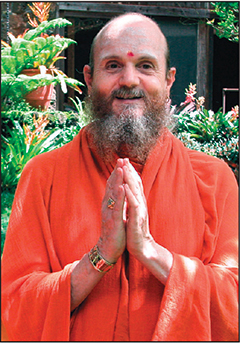 SOME MONTHS BACK IN AUSTRALIA, A GROUP OF Hindu teens asked me what relevance Hinduism and temples have to modern life. They said it as though the answer were obvious: None. But they were callow and yet to be schooled in the noble religion they had been born into. After our session, their question echoed in my mind for days. It is a question on many minds, deserving a complete answer. I would like to share with our readers the four major virtues that I singled out for those students, virtues which make Hinduism profoundly relevant in today’s world: nonviolence, tolerance, worship and life’s four noble goals.§
SOME MONTHS BACK IN AUSTRALIA, A GROUP OF Hindu teens asked me what relevance Hinduism and temples have to modern life. They said it as though the answer were obvious: None. But they were callow and yet to be schooled in the noble religion they had been born into. After our session, their question echoed in my mind for days. It is a question on many minds, deserving a complete answer. I would like to share with our readers the four major virtues that I singled out for those students, virtues which make Hinduism profoundly relevant in today’s world: nonviolence, tolerance, worship and life’s four noble goals.§
The Virtue of Nonviolence: On November 13, 2006, we watched with interest a television report on the groundbreaking ceremony inaugurating a memorial to American civil rights hero Dr. Martin Luther King, Jr., in Washington’s front yard, the National Mall. President Bush said he was proud to dedicate the memorial in its “rightful place,” between monuments to Thomas Jefferson, who “declared the promise of America,” and Abraham Lincoln, “who defended the promise of America.” Dr. King, Bush offered, “redeemed the promise of America.”§
Dr. King came from a staunch Christian family. His grandfather was a Baptist preacher. His father was pastor of Atlanta’s Ebenezer Baptist Church. King earned his own Bachelor of Divinity degree from Crozer Theological Seminary in 1951 and his Doctor of Philosophy from Boston University in 1955. While at the seminary, King became acquainted with Mohandas Gandhi’s philosophy of nonviolent social protest. On a trip to India in 1959, King met with followers of Gandhi. During these intimate discussions, he became more convinced than ever that nonviolent resistance is the most potent weapon available to oppressed people in their struggle for freedom.§
Dr. King went on to effectively utilize the Gandhian principles of nonviolent social protest to bring to the world’s attention the unjustness of US racial discrimination laws, which were subsequently changed. Dr. King and all the millions he impacted would certainly affirm the relevance of the key Hindu principle of nonviolence in modern society.§
The world has changed significantly in the aftermath of September 11, 2001. Everyone has become more aware, and increasingly appalled, by the rampant incidents of brutality occurring worldwide every month. A great deal of violence is based upon the concept of the strategic necessity of retaliation—”An eye for an eye.” “If they kill one of us, we must kill one of them.” Contrarily, Hindus view retaliation as unwise. Gandhi made an insightful statement to counterpoint the call for revenge. He warned: “An eye for an eye makes the whole world blind.” He also declared, “I object to violence because when it appears to do good, the good is only temporary; the evil it does is permanent.” §
In a world awash in wars and conflict of every kind, Hinduism’s gentleness and noninjury by thought, word and deed is more than relevant. It is a necessity for the future of humanity.§
The Wisdom of Tolerance: The Hindu value that complements and underlies the principle of nonviolence is that of tolerance. The Hindu belief that gives rise to tolerance of differences in race, religion and nationality is that all of mankind is good; we are all divine beings, souls created by God. Hindus do not accept the concept that some individuals are evil and others are good. Hindus believe that each individual is a soul, a divine being, who is inherently good. The Upanishads tell us that each soul is emanated from God, as a spark from a fire, and thence begins a spiritual journey which eventually leads back to God. All human beings are on this journey, whether they realize it or not. The Upanishadic mahavakyam, or great saying, that expresses this is Ayam atma brahma, “the soul is God.” The Hindu practice of greeting one another with namaskara, worshiping God within the other person, is a way this philosophical truth is practiced on a daily basis.§
This is taken one step further in the Vedic verse Vasudhaiva kutumbakam, “The whole world is one family.” Everyone is family oriented. All that we do is for the purpose of benefiting our family. We want them all to be happy, successful and religiously fulfilled. And when family is defined as the whole world, then it is clear that we wish everyone in the world to be happy, successful and religiously fulfilled. The Vedic verse that captures this sentiment is Sarve janah sukhino bhavantu, “May all people be happy.” Certainly the key principle of tolerance is a major demonstration of the relevance of Hindu teachings to our modern world in providing a more compassionate and universalistic worldview, one that embraces the growing pluralism in world societies.§
Effective Forms of Worship: One question the teens in Australia asked was, “If God is omnipresent, what is the need to build big temples to worship Him. The cost of construction is quite large; plus after it is built you have the ongoing cost of monthly maintenance. Couldn’t all that money be spent in a better way?”§
I asked a question in response: “Since God is omnipresent, shouldn’t we able to experience Him equally everywhere? For example, God permeates this room. By looking intently at the room shouldn’t you be able to experience God? In theory you should.” I then asked, “How many of you can see God permeating this room?” All present had to admit that they could not.§
Practically speaking, God’s omnipresence is a marvelously subtle form of consciousness, too subtle for most of us to experience unless we are skilled in meditation. I continued by giving the following series of analogies with other objects that are difficult to see. If we want to see a distant galaxy, we must go to an observatory and use a powerful telescope. To look into the nucleus of a cell, we go to a laboratory and use an electron microscope. Similarly, to see God, we go to the temple and experience God through the sanctified murti, or statue, of the Deity. Temples—and particularly the murtis within them—can connect us with the Divine because they are especially sacred. There are three reasons for this: construction, consecration and continuous daily worship.§
A temple is designed and built according to strict rules laid down in scripture. This governs what shrines are included in the temple, the shrines’ location and the overall dimensions of the temple. Consecration occurs through the powerful ceremony called kumbhabhishekam, during which a large number of priests perform elaborate rites for days on end. Thereafter begins the routine of daily worship conducted by professional priests. In these three ways, the temple and the murtis within them are sanctified and endowed with potent energies.§
Hindu temples in every corner of the world offer Hindus an achievable way to experience God’s sacred presence. Divinity’s presence uplifts those attending the temple, inspiring them to bring forth and perpetuate traditional Hindu culture in the form of sacred music, art and dance. As such, the temple becomes the hub of religious life in the surrounding Hindu community and thus is undeniably relevant to modern life.§

DINODIA§
Kids want to know: Like so many children all over the world, this young girl enjoys ready access to information of every kind. Her father wisely supervises her Internet explorations. Hinduism offers an ethical and philosophical framework that, if taught to the young, helps keep everything in proper perspective and guides them on a path of earthly success, intellectual growth and spiritual progress.§
Four Noble Pursuits: Hinduism’s relevance to modern life is perhaps most personally important in the sphere of spiritual fulfillments and worldly attainments. Each Hindu seeks the highest and best for self and family, including closeness to God and blessings in every arena of experience. Hinduism has tools, maps and guidelines for reaching those very human goals. Consider the concept of the purusharthas, Hinduism’s four traditional pursuits. The first two are wealth and love, known in Sanskrit as artha and kama. Common to all mankind, these embrace the pursuit of love, family, children, career and financial abundance. The third is dharma, which provides direction and balance to the first two. Dharma is piety, virtue and right living. It includes the ideals of seeking wealth and love in an ethical manner, being honest in business and loyal to one’s spouse. The fourth noble pursuit is moksha, spiritual illumination and liberation from rebirth on Earth. Liberation comes when all our karmas are resolved, dharma has been fulfilled and God has been realized. Hindus know that dharma, artha and kama are not ends in themselves. They provide the necessary surroundings, relationships and experiences which help the embodied soul mature over many lives and attain an ever-deepening God consciousness. This maturing process eventually culminates in moksha, at which point the soul has outgrown the need to continue its cycle of birth, death and rebirth. The goal of moksha, which sharply distinguishes Hinduism from Western religions, reminds us not to become so enthralled with the world that we neglect our foremost aim: God realization and liberation.§
It is hard to imagine a mega-message greater than Hinduism’s call for human concord, noble aims for our worldly existence and spiritualizing of our daily life. In addressing these fundamental human needs, no system of thought and theology is more germane. Having visited communities around the world, I am convinced that Hinduism remains vitally relevant in this era of space travel and global communications, and of worldliness and conflict on every continent. This vitality derives from its yoga, its teaching of all-pervasive Divinity, its health system of ayurveda, its mystical architectural system of vastu, its immense cultural gifts and so much more. It is relevant in providing the human race a profound self-understanding—illumined insights into life and consciousness, into human nature and our highest purposes. We can restate the Australian youths’ question: “Is there any religion in the world that is more relevant today than Hinduism?” Our answer is a resounding no.§


